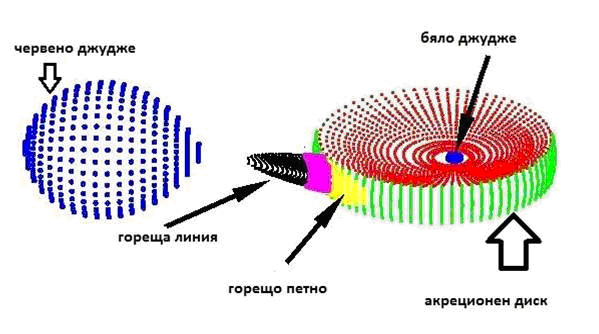The discovered at NAO Rozhen cataclysmic star
2MASS J01074282 4845188
is an unique object with rather extreme characteristics
June 13, 2013
In 2011, at the National Astronomical Observatory (NAO) – Rozhen, Bulgarian astronomers discovered nova-like cataclysmic star 2MASS J01074282 4845188 (hereafter it will be referred as J0107).
Initially, this star attracted the attention by the regular decrease of the brightness by about 3 magnitudes, which is the deepest eclipse among the known stars of this rare type. This unexpected behavior of J0107 motivates the astronomers to carry out follow-up study of this exotic astronomical object.
The analysis of the obtained photometric and spectral observations of the newly discovered cataclysmic star J0107 in 2012 at NAO Rozhen led to the conclusion that they could be explained by the extreme values of the global parameters of this system. Data were reproduced by modern model of cataclysmic star, which takes into account the contribution not only of the two stellar components (cool star and white dwarf) and the accretion disk, but also the effects of the so-called hot spot and hotline (Fig. 1).
It was found that the deep light minimum is result of the eclipse of very bright accretion disk contributing the bulk of the emission of the entire stellar system. The temperature of the inner edge of the disk is 50000 K, which is almost 2 times higher value of than the typical temperature of the accretion discs of cataclysmic variables at quiescence, but is appropriate value for the temperature of such objects during their outbursts.
The obtained temperature of the primary star of J0107 is about 40000 K, which means that this is one of the hottest white dwarfs found in cataclysmic variables.
It was not surprising that the temperature of the J0107 secondary component of 5090 K is much higher than the typical values of 3000 K for red dwarfs in cataclysmic variables. This is explained as a result of an intense heating of the secondary from the hot white dwarf and hot accretion disk.
Another unexpected result of the modeling was the relatively flat temperature distribution along the disk radius. It deviates considerably from the black-body energy distribution, which leads to the conclusion that the emission of the J0107 disk is non-stationary. This effect is explained by the low viscosity of the disc matter due to its unusually high temperature.
The high value of mass transfer from the secondary to the primary star in the system means that the evolutionary stage of J0107 is very short.
The found similarities of the characteristics of the newly discovered J0107 and cataclysmic variables at outbursts give new arguments to the hypothesis that nova-like stars are cataclysmic objects that are continuously at high state.
It is known that the discovery of cataclysmic variables is rare because they are faint objects. The eclipsing nova-like stars are still more rare phenomenon (only a few dozen are known). But these are most important for the astrophysics because they give a possibility for the determination of the global parameters and thus contribute to the study of the final stages of the stellar evolution.

Fig. 1. 3D art model of nova-like cataclysmic star
The extreme values of the global parameters (especially the temperature ones) show that 2MASS J01074282+4845188 is an unique object among the cataclysmic stars and interesting target for future detailed spectral observations as well as observations in the ultraviolet and X-ray range.
The following animations give an imagination on the reasons for the complex changes of the brightness of the nova-like cataclysmic variables.
Observations, research and modeling of the newly discovered cataclysmic star 2MASS J01074282 +4845188 were made by the astronomers Dinko Dimitrov (Institute of Astronomy with NAO, BAS), Diana Kjurkchieva (Shumen University) and Tatyana Khruzina (Sternberg Astronomical Institute, Moscow).
The results of this study are published in the paper „The SW Sextantis-type star 2MASS J01074282+4845188: an unusual bright accretion disk with non-steady emission and a hot white dwarf" (2013, Astronomy & Astrophysics 551A, 125).